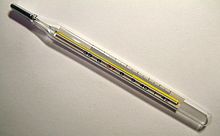| Febrile seizure | |
|---|---|
| Other names | Fever fit, febrile convulsion |
 | |
| An analog medical thermometer showing a temperature of 38.8 °C or 101.8 °F | |
| Specialty | Emergency medicine, neurology |
| Symptoms | Tonic-clonic seizure[1] |
| Usual onset | Ages of 6 months to 5 years[1] |
| Duration | Typically less than 5 minutes[1] |
| Types | Simple, complex[1] |
| Causes | High body temperature[1] |
| Risk factors | Family history[1] |
| Differential diagnosis | Meningitis, metabolic disorders[1] |
| Treatment | Supportive care[1] |
| Medication | Benzodiazepines (rarely needed)[1] |
| Prognosis | Good[1] |
| Frequency | ~5% of children[2] |
A febrile seizure, also known as a fever fit or febrile convulsion, is a seizure associated with a high body temperature but without any serious underlying health issue.[1] They most commonly occur in children between the ages of 6 months and 5 years.[1][3] Most seizures are less than five minutes in duration, and the child is completely back to normal within an hour of the event.[1][4] There are two types: simple febrile seizures and complex febrile seizures.[1] Simple febrile seizures involve an otherwise healthy child who has at most one tonic-clonic seizure lasting less than 15 minutes in a 24-hour period.[1] Complex febrile seizures have focal symptoms, last longer than 15 minutes, or occur more than once within 24 hours.[5] About 80% are classified as simple febrile seizures.[6]
Febrile seizures are triggered by fever, typically due to a viral infection.[6] They may run in families.[1] The underlying mechanism is not fully known, but it is thought to involve genetics, environmental factors, brain immaturity, and inflammatory mediators.[7][8][6] The diagnosis involves verifying that there is not an infection of the brain, there are no metabolic problems, and there have not been prior seizures that have occurred without a fever.[1][6] Blood testing, imaging of the brain, or an electroencephalogram (EEG) is typically not needed.[1] Examination to determine the source of the fever is recommended.[1][6] In otherwise healthy-looking children a lumbar puncture is not necessarily required.[1]
Neither anti-seizure medication nor anti-fever medication are recommended in an effort to prevent further simple febrile seizures.[1][9] In the few cases that last greater than 5 minutes, a benzodiazepine such as lorazepam or midazolam may be used.[1][10] Efforts to rapidly cool during a seizure is not recommended.[11]
Febrile seizures affect 2–10% of children.[2] They are more common in boys than girls.[12] After a single febrile seizure there is an approximately 35% chance of having another one during childhood.[6] Outcomes are generally excellent with similar academic achievements to other children and no change in the risk of death for those with simple seizures.[1] There is tentative evidence that affected children have a slightly increased risk of epilepsy at 2% compared to the general population.[1]
- ^ a b c d e f g h i j k l m n o p q r s t u v w x Graves RC, Oehler K, Tingle LE (January 2012). "Febrile seizures: risks, evaluation, and prognosis". American Family Physician. 85 (2): 149–53. PMID 22335215.
- ^ a b Gupta A (February 2016). "Febrile Seizures". Continuum (Minneapolis, Minn.). 22 (1 Epilepsy): 51–9. doi:10.1212/CON.0000000000000274. PMID 26844730. S2CID 33033538.
- ^ Cite error: The named reference
Stat2019was invoked but never defined (see the help page). - ^ "Symptoms of febrile seizures". www.nhs.uk. 1 October 2012. Archived from the original on 6 October 2014. Retrieved 13 October 2014.
- ^ Cite error: The named reference
AAP2017was invoked but never defined (see the help page). - ^ a b c d e f Cite error: The named reference
Leu2018was invoked but never defined (see the help page). - ^ Cite error: The named reference
BMJ2015was invoked but never defined (see the help page). - ^ Cite error: The named reference
Kwon2018was invoked but never defined (see the help page). - ^ Offringa M, Newton R, Nevitt SJ, Vraka K (16 June 2021). "Prophylactic drug management for febrile seizures in children". The Cochrane Database of Systematic Reviews. 2021 (6): CD003031. doi:10.1002/14651858.CD003031.pub4. ISSN 1469-493X. PMC 8207248. PMID 34131913.
- ^ Prasad P (2013). Pocket Pediatrics: The Massachusetts General Hospital for Children Handbook of Pediatrics. Lippincott Williams & Wilkins. p. 419. ISBN 9781469830094. Archived from the original on 6 September 2017.
- ^ "Febrile Seizures". familydoctor.org. Retrieved 24 January 2020.
- ^ Ronald M. Perkin, ed. (2008). Pediatric hospital medicine : textbook of inpatient management (2nd ed.). Philadelphia: Wolters Kluwer Health/Lippincott Williams & Wilkins. p. 266. ISBN 9780781770323. Archived from the original on 6 September 2017.